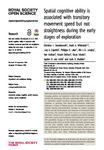Spatial cognitive ability is associated with transitory movement speed but not straightness during the early stages of exploration
| dc.contributor.author | Beardsworth, CE | |
| dc.contributor.author | Whiteside, Mark | |
| dc.contributor.author | Capstick, LA | |
| dc.contributor.author | Laker, PR | |
| dc.contributor.author | Langley, EJG | |
| dc.contributor.author | Nathan, R | |
| dc.contributor.author | Orchan, Y | |
| dc.contributor.author | Toledo, S | |
| dc.contributor.author | van Horik, JO | |
| dc.contributor.author | Madden, JR | |
| dc.date.accessioned | 2021-04-14T14:04:40Z | |
| dc.date.available | 2021-04-14T14:04:40Z | |
| dc.date.issued | 2021-03 | |
| dc.identifier.issn | 2054-5703 | |
| dc.identifier.issn | 2054-5703 | |
| dc.identifier.other | rsos.201758 | |
| dc.identifier.uri | http://hdl.handle.net/10026.1/17044 | |
| dc.description.abstract |
<jats:p> Memories about the spatial environment, such as the locations of foraging patches, are expected to affect how individuals move around the landscape. However, individuals differ in the ability to remember spatial locations (spatial cognitive ability) and evidence is growing that these inter-individual differences influence a range of fitness proxies. Yet empirical evaluations directly linking inter-individual variation in spatial cognitive ability and the development and structure of movement paths are lacking. We assessed the performance of young pheasants ( <jats:italic>Phasianus colchicus</jats:italic> ) on a spatial cognition task before releasing them into a novel, rural landscape and tracking their movements. We quantified changes in the straightness and speed of their transitory paths over one month. Birds with better performances on the task initially made slower transitory paths than poor performers but by the end of the month, there was no difference in speed. In general, birds increased the straightness of their path over time, indicating improved efficiency independent of speed, but this was not related to performance on the cognitive task. We suggest that initial slow movements may facilitate more detailed information gathering by better performers and indicates a potential link between an individual's spatial cognitive ability and their movement behaviour. </jats:p> | |
| dc.format.extent | 201758-201758 | |
| dc.format.medium | Electronic | |
| dc.language | en | |
| dc.language.iso | en | |
| dc.publisher | Royal Society, The | |
| dc.subject | movement ecology | |
| dc.subject | cognition | |
| dc.subject | spatial memory | |
| dc.subject | accuracy | |
| dc.subject | speed | |
| dc.subject | straightness | |
| dc.title | Spatial cognitive ability is associated with transitory movement speed but not straightness during the early stages of exploration | |
| dc.type | journal-article | |
| dc.type | Journal Article | |
| plymouth.author-url | https://www.webofscience.com/api/gateway?GWVersion=2&SrcApp=PARTNER_APP&SrcAuth=LinksAMR&KeyUT=WOS:000627842300001&DestLinkType=FullRecord&DestApp=ALL_WOS&UsrCustomerID=11bb513d99f797142bcfeffcc58ea008 | |
| plymouth.issue | 3 | |
| plymouth.volume | 8 | |
| plymouth.publication-status | Published | |
| plymouth.journal | Royal Society Open Science | |
| dc.identifier.doi | 10.1098/rsos.201758 | |
| plymouth.organisational-group | /Plymouth | |
| plymouth.organisational-group | /Plymouth/Faculty of Science and Engineering | |
| plymouth.organisational-group | /Plymouth/Faculty of Science and Engineering/School of Biological and Marine Sciences | |
| plymouth.organisational-group | /Plymouth/Users by role | |
| plymouth.organisational-group | /Plymouth/Users by role/Academics | |
| dc.publisher.place | England | |
| dcterms.dateAccepted | 2021-02-19 | |
| dc.rights.embargodate | 2021-4-20 | |
| dc.identifier.eissn | 2054-5703 | |
| dc.rights.embargoperiod | Not known | |
| rioxxterms.versionofrecord | 10.1098/rsos.201758 | |
| rioxxterms.licenseref.uri | http://www.rioxx.net/licenses/all-rights-reserved | |
| rioxxterms.licenseref.startdate | 2021-03 | |
| rioxxterms.type | Journal Article/Review |


